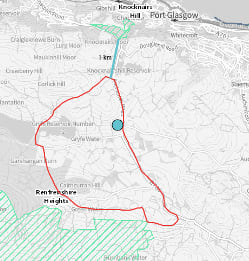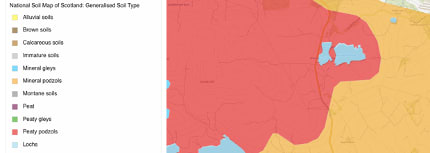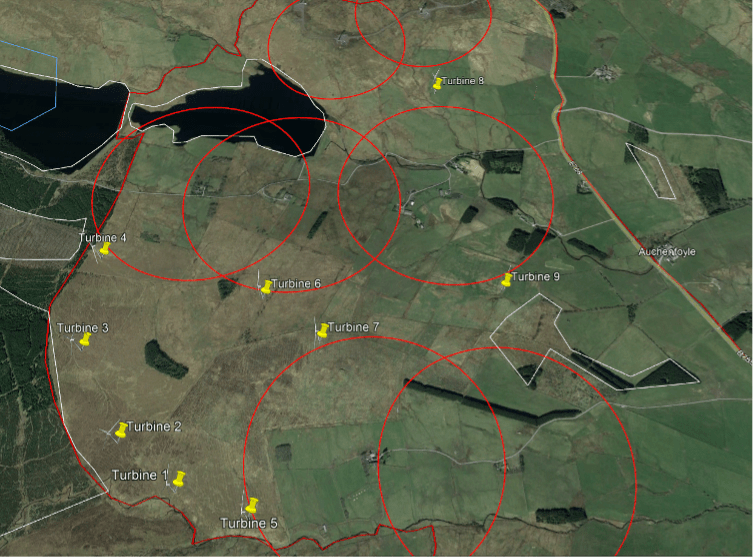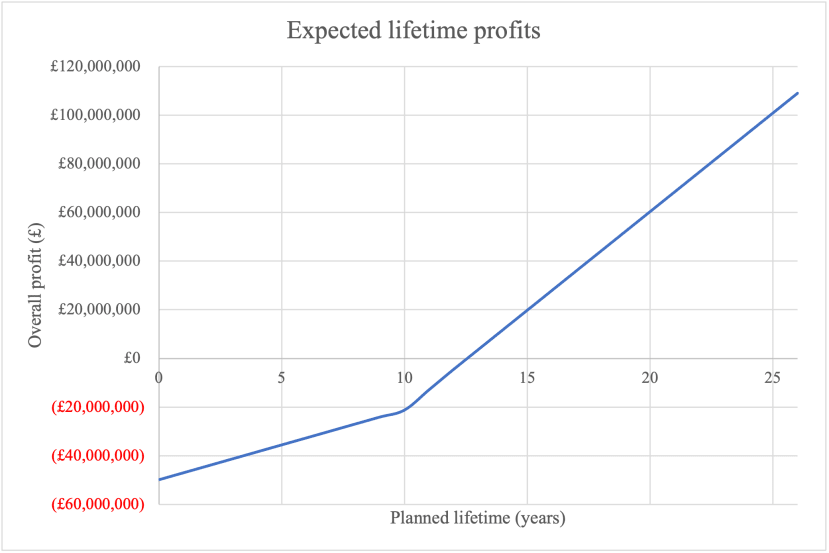ScotWind Solutions Wind Farm
Follow articleHow do you feel about this article? Help us to provide better content for you.
Thank you! Your feedback has been received.
There was a problem submitting your feedback, please try again later.
What do you think of this article?
Location Justification
The development of a wind farm involves multiple aspects in terms of siting, feasibility, financial planning, social and environmental impacts. Therefore, for each location, we identified any feasibility concerns, extra financial costs, social disapproval, and environmental concerns, which are listed below.
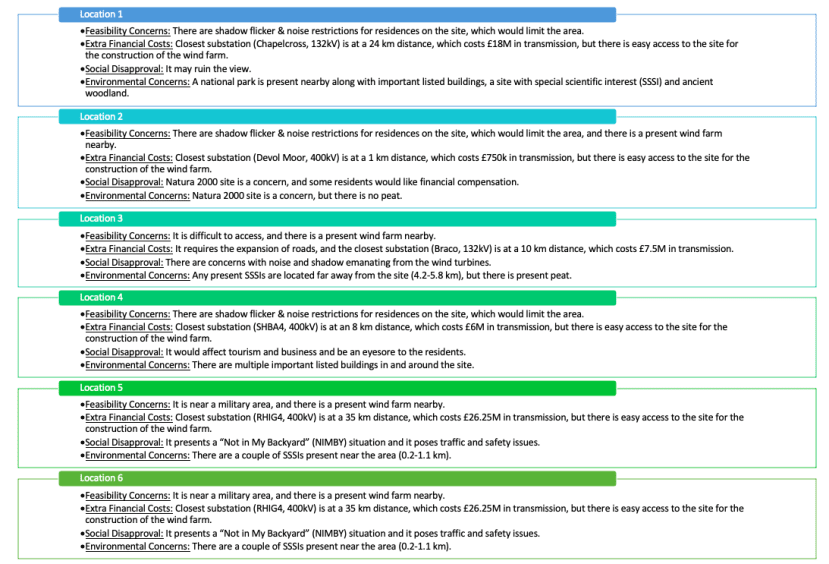
|
Criteria |
Weight |
Location 1 |
Location 2 |
Location 3 |
Location 4 |
Location 5 |
Location 6 |
|
Feasibility Concerns |
5 |
6 |
7 |
7 |
6 |
8 |
6 |
|
Extra Financial Costs |
5 |
6 |
2 |
6 |
4 |
8 |
6 |
|
Social Disapproval |
4 |
2 |
4 |
2 |
4 |
7 |
6 |
|
Environmental Concerns |
3 |
8 |
4 |
4 |
8 |
5 |
6 |
|
Total |
92 |
73 |
85 |
90 |
123 |
102 |
Then, the lowest scoring locations (the criteria are negative, so a low score coincides with a better location), which were locations 2 and 3 were assessed on WAsP. The WAsP assessment for location 3 resulted in high wake losses of around 15% due to the nearby wind farm, whereas, location 2 only experienced wake losses of 6%. Consequently, location 2 was chosen as our preferred location.
Some mapping of Location 2 reveals the presence of a special protection area (Natura 2000 site) and a lack of peat.
Wind Turbine Placement
By taking into consideration buffers for noise, shadow flicker, waterbodies, roads, and the nearby wind farm, we proposed this technical design for the wind turbine placement using WAsP software and Google Earth. As shown in the figure below, the space limitations from the above considerations were significant. Within the limitations we allowed for a 5D (turbine diameter) turbine spacing in the prevailing wind direction and 3D in the cross-wind direction. In terms of topography, we tried our best to locate turbines of the upward slope of windward hills, however, this was not consistently possible due to the space limitations.
Social Impacts
This section entails assessing social concerns and positives that would result from the development of the wind farm on this location, and, consequently, the formation of a community engagement plan is necessary to assure the residents that they are listened to due to the fact that they are a core value in our company. These were all included in our social proposal.
The drafted social proposal sent out to the Inverclyde Local Council and Residents can be seen below:
We, ScotWind Solutions, would like to utilize a portion of your land to build a wind farm, consisting of 9 turbines and a rated capacity of 50.4 MW in total. However, we acknowledge your concerns regarding house prices and the presence of a Special Protection Area (SPA) near the site, and we would like to attempt to alleviate them as you are an integral part of our project.
For starters, regarding the Natura 2000 site, in order to ensure the safety of the species inhabiting the area, an ecologist will be recruited to conduct surveys and impact assessments by monitoring the activity of the species. Based on the results, we will mitigate any risks by installing appropriate technology, such as detectors or the application of black paint on the turbine blades, to mitigate bird collision. When it comes to the soil on which the wind farm will be built, based on preliminary research, the land mostly consists of mineral podzols rather than peat, and mineral podzols have no use in terms of agriculture or forestry as it is very infertile. In terms of house prices, the development of this project will eventually lead to the provision of community benefits, consisting of an annual payment of £252,000. Any other concerns, such as emanating noise and shadow from the wind turbines, will be addressed through spatial planning and the placement of the wind turbines at a suitable distance away from your homes.
The development of this wind farm will have a positive impact on your community as well. For instance, it can provide 13% of your total energy consumption. Moreover, it can instigate a rise in employment by creating apprenticeships that would be a part of the development and construction of the wind farm or by engaging with local business communities.
As mentioned previously, you will be an intrinsic part of planning from the beginning to the end of the life of the wind farm. This can be seen through our community engagement strategy below:
Pre-project phase:
A spatial approach will be implemented to account for early community engagement. Therefore, a proposal of the zones the wind turbines will placed on will be drafted to the public, and then, a consultation on the zone designation will occur. Any concerns provided in the consultation will be considered in the placement plan of the wind turbines.
Pre-application phase:
- Awareness raising events will include the development of a website, sending out leaflets and mailings, as well as the arrangement of site visits involving the public. Furthermore, door-knocking will be one of our engagement mechanisms.
- A public hearing will occur in the form of a workshop. Moreover, a freepost address and a freephone number would be given to the public to maintain connection with the community and address any concerns.
- A community liaison group will be formed with an appointed spokesperson to negotiate interests between us and the local community, and, if any concerns come up in terms of noise, wildlife, shadow etc., they will be addressed accordingly. It is important to note that this will be exist throughout the project lifetime should any concerns arise.
Post-application phase:
- All documents will be displayed in order to ensure transparency and information provision.
- A public hearing will be arranged, and written comments and feedback will be addressed.
Post-approval phase:
- More information provision sessions will occur in the form of leaflets, updating our website, and through the school education program.
- Any potential appeals will be implemented.
Post-commissioning phase:
- A community benefit fund will be implemented and information regarding it will be relayed to the public.
- Apprenticeships will be set up, and people in the community will be given priority in terms of employment, depending on their skill.
- The community liaison group, freephone number, and freepost address will be our primary forms of engagement with the community in order to alleviate any concerns.
- The public will be updated with any new information.
The Local Council and Residents looked over our proposal and had a few questions, and the correspondence can be seen below:
Dear ScotWind Solutions,
Thank you for your detailed and insightful proposal. The community are encouraged to see the efforts that you are going to to maintain an open line of communication with local residents and are grateful for your attempts to minimise the negative impacts of the development on our area. We do, however, have some questions for you.
- We were wondering if you have proposed times throughout the day during which you will conduct transportation of your materials and if you will conduct any research to identify times which will cause the least disruption to our community when using public roads?
- We were pleased to see that you are considering a school's education programme, and would like to hear more about what this will entail. How will you use the development to engage and educate the young people in our area?
We look forward to working with you in the community.
Kind regards,
Inverclyde Local Council and Residents
In reply:
Hello,
We are appreciative of you taking the time to look over our social proposal. To answer your questions:
- Regarding the transportation of the materials, to begin with, we will try to find the best route from the source of our materials to the site. Then, we will be conducting traffic surveys to find the times when traffic is at its peak, which would aid in avoiding rush hours and inconveniencing residents. Ideally, we would aim to avoid times when residents are coming from school and work, so perhaps nighttime is the most appropriate time for transportation. However, this needs to be confirmed with research on the road network. It may also be better to utilise on-site material sourcing, such as on-site cement making.
- Regarding the school education programme, we can create workshops and assign projects, entailing the design of wind farms in the pre-construction and construction phases. Moreover, we would create regulated site visits so they could witness how a wind turbine is constructed. It is important to ensure that students learn from our development of the wind farm in terms of both theory and practise.
I hope this answers your questions and please let me know if you need any additional clarification.
Thank you for your time and consideration and we look forward to working with you.
Kind regards,
ScotWind Solutions
Energy Yield & Financial Planning
For our wind farm, we utilized 9 turbines with a rated capacity of 5.6 MW each, resulting in a total rated capacity of 50.4 MW. The attributes for our wind farm in terms of losses and the energy production are as follows in the tables.
|
Category |
Losses |
Justification |
|
Wakes |
6.30% |
WASP Analysis |
|
Wind farm availability |
4% |
Built up area, close proximity to multiple substations. |
|
Electrical losses |
1% |
Small wind farm (9 Turbines), close to substation (1km). |
|
Wind turbine performance |
3% |
Cautious estimate, to be adjusted upon further consultaion with manufacturer. |
|
Environmental losses |
3% |
Average temperatures rarely below 0 degrees, although high humidity and altitude of turbines makes icing a minor concern in the winter months. |
|
Curtailment |
4% |
Close proximity to houses and forests, turbines running at higher end of capabilities. |
|
Gross annual production |
Net annual production |
Capacity factor |
|
237 GWh |
191 GWh |
43.14% |
Regarding our financial forecast, we considered the costs in the foundation year (year 0) to cover wind turbine generator, rent, maintenance, grid connection, initial building or surveying cost and community engagement plan. The cumulative resulted in a cost of £49,912,000. Therefore, we created a loan application that was sent to the bank, requesting the specified loan amount with a 1% interest rate to be repaid over 10 years. After the foundation year, we generate revenue from selling the electricity, but also need to take account of other annual running expenses such as rent, maintenance costs, the community benefit fund, as well as the 10-year loan repayment plan on an annual basis. . Based on this information, a payback analysis and NPV calculation was done, and the results can be seen below.
|
Breakeven Point |
Year 12 |
|
Return on Investment |
218% |
|
NPV1 using 8% depreciation |
£2.8M |
|
IRR from NPV1 |
8.5% |
|
NPV2 accounting for 5% profit inflation |
£53M |
|
IRR from NPV2 |
13% |
Environmental Impacts
It is important to perform an environmental impact assessment in order to consider the environmental impacts that can be instigated from the wind farm development. The assessment can be seen in the table below.
|
Category |
Risks |
Probability |
Severity |
Overall Impact |
Mitigation Strategies |
|
Water Quality & Availability
|
Water abstraction, morphological alterations to banks of adjacent watercourses (excessive siltation) surface water and river flooding |
M |
H |
Significant |
Settlement pits (diffuse pollution), Culverting, Flood management methods, Buffer Strips, Connect to drainage, Use Watercourse crossings |
|
Biodiversity (Flora, Fauna)
2 SPA’s/Ramsar sites (Renfrewshire Heights, Inner Clyde Estuary 7 SSSI’s Dargavel Burn, Dunrod Hill, Glen Moss, Inner Clyde, Knocknairs Hill, Renfrewshire Heights, Shielhill Glen)
|
Encroachment into SPAs and SSSIs, Direct habitat loss or fragmentation, disturbance to protected species, Increase of invasive non-native species, felling of trees and shrubs within the site |
L |
H |
Moderate |
Site survey to track flying routes, identify nesting/feeding areas, Enhancements to biodiversity, e.g. through improvements to habitats linked to new development sites, or the expansion of woodland cover. |
|
Soils |
Loss or degradation of carbon rich soils, contamination or erosion caused by surface water runoff, contamination from substances used in construction, cleaning and redevelopment, peat slides can occur in very wet weather
|
M |
H |
Significant |
Minimise or avoid peat excavation |
|
Air Quality |
Dust, particulate matter release &transfer, carbon emissions from HGVs during construction phase, presence of HGVs |
H |
M |
Significant |
Utilize exisiting access routes as much as possible, Siting of laydown area/ substation close to access routes, Intermittent dampening of area |
It is also important to add that the wind farm layout will take account of habitat type and designated sites and avoid the most sensitive areas in order to minimise impacts. Within the boundary, infrastructure will be located as far as possible within the habitat of least ecological value and the proposed track network will also attempt to make much use of existing tracks or access routes. Detailed siting of infrastructure at the construction phase would further seek to minimise impacts on the higher quality habitats. However, currently, this is the preliminary information we have acquired regarding the species inhabiting the areas near the site.
- Special Protection Area (SPA), together with their component Sites of Special Scientific Interest (SSSI), lies adjacent to the site boundary. The Renfrewshire Heights is a range of undulating moorland hills with carboniferous basalts, and minerals such as baryte and copper. Protected species include the breeding hen harriers. The Inner Clyde Estuary (Ramsar, SPA, SSSI site) consists of tidal mudflats which serve as feeding areas for waders during the winter. Other waterbird species include the redshank, cormorants, oystercatchers, red-throated divers etc. Glen Moss and Sheilhill Glen are a combination of woodland, and marshland as well as shallow pools. Common species include songbirds, winterfowl, insects (dragonflies, damselflies), green tiger beetles, lizards.
- The Port Glasgow Angling Club owns the Loch Gryffe rivers (within/close to the site boundary), the Harelaw and the Knocknair reservoirs. Animals in the Gryffe reservoirs include farmed brown trout and the wild brown trout which may be affected by siltation or flooding.
Risk Mitigation, Maintenance & Decommissioning Strategies
Risks occur in every phase of the development of your wind farm, and that includes the construction stage of the wind farm. Below, you can find some risks regarding on-site construction of wind turbines, and mitigation methods that need to be considered.
|
Risk |
Mitigation Method |
|
Electric Work |
Use insulators Make sure the power is off before starting the work Take notice of signs & warnings |
|
Weather Conditions |
PPE, appropriate clothing, sunscreen, consistent breaks |
|
Vehicle Collisions/Pedestrian Safety |
Use barriers Keep a distance |
|
Manual Handling |
10% to 15% of the body weight Manual Handling Training |
|
Handling concrete |
Keep a distance Wear safety goggles and gloves and special protective suit Abide by procedures if any burns occur |
Regarding maintenance, multiple strategies exist that can be utilized. However, they can be mainly divided into preventative and corrective procedures. Preventative maintenance will be carried out twice a year and requires a checklist to update each turbine's maintenance history and confirm its current state. Among the list's requirements is checking the hydraulic system and gearbox oil levels, oil leaks, oil filters, and the security of fixings, such as the blade attachment and tower base bolt. Furthermore, the brake disc, emergency escape equipment, the cables that run down the tower, and the systems that support them need to be checked. Any unusual drive train vibrations from the machine's running must also be considered. On the other hand, corrective maintenance will occur in response to components' wear and tear, human errors, design faults, and operational factors, such as overspeeding, excessive vibration, low gearbox oil pressure, yaw error, and pitch error. Additionally, this type of maintenance occurs during a routine inspection or when the protection system shuts down the turbines in response to a developing fault.
For the decommissioning process, the following points have been considered:
- Return sites to their pre-project conditions as precisely as is reasonably possible following the removal of turbines and associated infrastructure (reseeding plants, decompacting the ground, and repairing any broken drainage tiles).
- Define a removal depth to enable certain underground infrastructure (such as wiring and foundation) to stay in situ owing to the environmental effects of total removal & ensure that future land use is not hampered by the existing infrastructure.
- Dispose resources, such as concrete, metals & composites by considering pollution prevention guides and risks associated with the materials.
- Conduct research into the repurposing or recycling of wind turbine blades and other components to promote environmental sustainability

